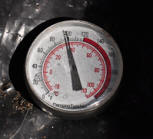Micro-Organisms - As the name
implies, these are critters that cannot generally be viewed with the
unaided eye. They are the tiny workers who do much of the work of
composting. Included in this group would be bacteria, fungi, molds
and protozoa.As the microorganisms do their thing in the pile,
they will also generate some heat. In fact, these organisms can be
classified based on the amount of heat generated.
 1.
Psychophiles - These are the microorganisms that are
present in a compost pile at temperatures of 55 to 70 degrees F.
At this level, the rate of decomposition will be very slow. To
maintain this type of organism, very little active composting is
needed i.e. rarely turning the pile, no shredding, etc.
1.
Psychophiles - These are the microorganisms that are
present in a compost pile at temperatures of 55 to 70 degrees F.
At this level, the rate of decomposition will be very slow. To
maintain this type of organism, very little active composting is
needed i.e. rarely turning the pile, no shredding, etc.
2. Mesophiles - At temperatures between 70 to 100 degrees F.,
another type of bacteria becomes active which greatly increases
the rate of decomposition. To maintain this type of organism
group, you will need to periodically turn the pile and try to
maintain a good balance of
nitrogen and carbon in the pile.
3. Thermophiles - These are the "Super" bacteria that will
decompose the composting material at a rapid rate. These
critters will maintain temperatures of 100 up to 160 degrees F.
To achieve and keep a population of these organisms, the
composter will have to be very, very active. The pile will be
turned, balance, watered, etc. very frequently. At these
temperatures, plant diseases and weed seeds will be killed.



